Twelve final year undergraduate students majoring in Agricultural Extension at the University of Peradeniya organized a “Productivity Enhancement Training” as part of their academic programme. Yasara Kasthuriarachchi reflects on this experience here.
CONTEXT
Agriculture is the backbone of Sri Lankan economy. It plays a significant role in rural areas by providing livelihoods for more than 80% of the rural population. Apart from cultivation of paddy and other plantation crops, Sri Lankan farmers also grow a wide range of spices. However, the development of spice crop sector is slower than other sub-sectors of agriculture in Sri Lanka. The extension and advisory services (EAS) have to play a pivotal role in developing the potential of this sector, especially in provision of technical and marketing support to the currently under served smallholder spice farmers.
Realizing this context, the Department of Agricultural Extension of the Faculty of Agriculture, University of Peradeniya, conducted a ‘Productivity Enhancement Training’ program for selected rural farming community in Madulla, in the Central Province of Sri Lanka. Twelve final year undergraduate students majoring in Agricultural Extension conducted the program under the guidance of the academic staff.
Madulla is an area rich in scenic beauty. Majority of the villagers in Madulla cultivate spices, vegetables and rice with a focus on eco-friendly agriculture. Farming in the hilly terrain requires them to use Good Agricultural Practices (GAP).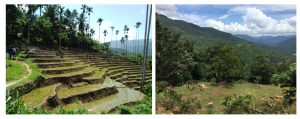
GOOD PRACTICES
1. Situation analyses
In order to get an initial idea about the village, information about Madulla was collected from the website of the Department of Census and Statistics. A checklist of questions was then prepared covering the socio-economic status of resident households and the five types of assets or capitals upon which livelihoods are built (human, physical, social, financial and natural). The team from the University visited the village and gathered information from village leaders and from some households located in different parts of the village.
2. Needs assessment
Participatory Rural Appraisal
Using the basic information gathered, a Participatory Rural Appraisal (PRA) exercise was planned to identify training needs of the selected community. A convenient day was identified for the PRA and all the stakeholders were invited to gather at the school located in the center of the village. About 75 participants representing the community organizations, field officers of government organizations and the villagers participated. A series of PRA tools, including a transect walk to get a basic idea about the ecology and agricultural environment in the area, was used.
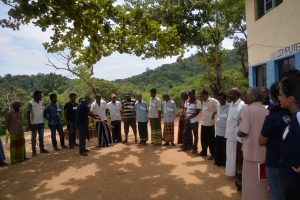
Group Discussions
Focus group discussions (FGDs) were held with two groups–one with female members of the village households and the other with senior students of the school. These discussions were particularly helpful in exploring the villagers’ genuine problems and also their feelings towards the University group that organized the program.
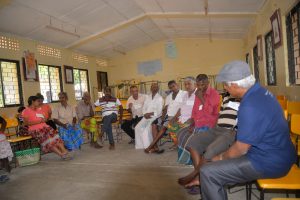
Village Map
Development of a village map was useful to understand the natural resources, infrastructure, public places, cultivation of crops and their distribution, and irrigation facilities. This activity was done by two groups because the area has three parts, namely: Madulla South, Madulla North and Morahela. Materials to draw the map were provided by the University students and they also helped to sketch the map according to the details provided by the villagers.
Matrix ranking
Matrix ranking of problems were undertaken to prioritize training needs. The major problems affecting the community that were identified were:
Lack of adequate pure drinking water
Lack of seed paddy and other planting materials
Absence of marketing support for pepper and other agricultural produce
Wild animal problem
Lack of knowledge regarding post-harvest practices and value addition
Migration of young people to urban areas.
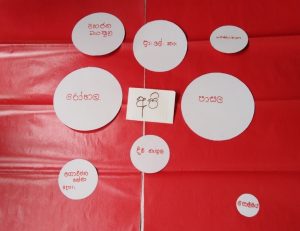
Venn diagram
Venn diagrams were helpful in identifying the interactions of the community with public and private sector institutions and community based organizations.
3. Planning the PET
Based on the findings of the appraisals carried out, four main training sessions were planned by the Extension Majors. The session plans and audiovisual training aids were designed and carefully developed with expert advice. After elaborate preparations and a series of rehearsals, the PET program was conducted in Madulla Secondary School.
4. Training (Productivity Enhancement Training)
Four training sessions were conducted in two consecutive days. Almost all the villagers participated in these sessions and a cultural show with songs, drama and other traditional acts of entertainment were performed in the evening of the first day.
The first training session was conducted by me on planting and maintenance of ginger and turmeric. To grab the attention of the audience, the session started with a roleplay, which ended with specially composed ‘Viridu’ song on the advantages of the two crops for Madulla village. It was nice to see the audience singing with the students.
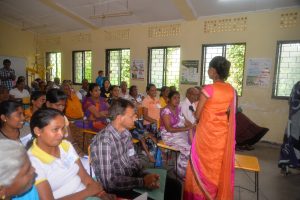
Since most farmers in the village had not started cultivation of the two crops, the training basically was meant to create a powerful motivation to engage in these highly economical enterprises. The importance of growing these crops and their uses were discussed with the participants through a Q&A session. Other aspects such as weather conditions, land preparation, time of planting, methods of establishment, agronomic practices and harvesting were discussed by exchanging ideas with those farmers having some experience in conventional methods in vogue.
The methods of planting were discussed using a flip chart, with drawings of various plot patterns that could be made. A small demonstration plot was set up to demonstrate proper spacing, planting material, planting and crop maintenance, etc. When they were asked to engage in the activity, the participants started to gain a sense of inclusion and responsibility for the activity they were involved in.
The discussion on preparation and application of organic manure using Glidiceria leaves and liquid cow dung was found to be interesting because Madulla village farmers are not interested in applying agro-chemicals. Two leaflets, including a summary of the technical content we had discussed in the field, was given to the farmers.
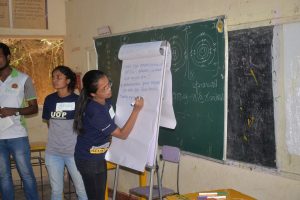
The second session was on entrepreneurship and what women can do to support household economy. The subsequent session focused on black pepper cultivation including its agronomic and post-harvest practices, development of value-added products and market information for pepper farmers, which was one of the major concerns at the time. The closing session was focused on youth in the village and discussions emphasized sprinkler and drip irrigation systems, and beekeeping.
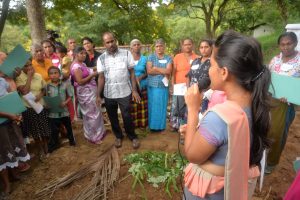
In collaboration with the Department of Export Agriculture and ‘Hadabima’ Authority of Sri Lanka, we distributed jackfruit and pepper plants as inspirational gifts to the participants. An exhibition stall was also arranged by the Department to provide further information, which was an added benefit to the participants.
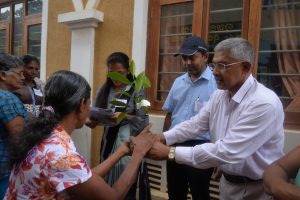
REFLECTIONS
This was my first great experience of training a group of elders to share knowledge and to convince them. I had to keep in mind that these adults had an immense sense of self and a strong belief in their past experiences. Some of them with their firsthand experience in the two cash crops could be engaged through questions and discussions, and were very helpful. It was important that they did not think we were trying to teach, but only want to share some of our knowledge with them.
The audience was supportive and enthusiastically engaged in all the training sessions. It felt most rewarding to me when they walked up to us and said “we didn’t notice the time passing” and some women in the village said “now you have become so familiar to us and feel like our own children” with tears in their eyes. It was the best feeling in the world at that moment.
The presence of academic staff and other officials from the Department of Export Agriculture, with expertise in the subject, added to my confidence as I was sure I am delivering precise content. All in all, it was one of the greatest experiences in my undergraduate life which taught me a lot and provided a lifetime worth of memories.
Prior practice and rehearsing presentations was very helpful in presenting our content clearly and confidently. Collective effort by everyone on the University team is highly praiseworthy. Guidance of professionals during the ‘Training of Trainers’ session at the University was very helpful.
Planning is really important in organizing this kind of an event while assigning unique activities to each member of the team is also important. We were able to learn about importance of effective communication, leadership and teamwork throughout the course.
Using more than one training method is key to adult learning. Providing gifts to farmers such as pepper and jackfruit plants helped in holding their attention throughout the program.
Adult learning methods are really different. Adults tend to learn if they are intrinsically motivated. To motivate them, we need to identify their needs and desire for recognition.

Ms. Yasara Kasthuriarachchi, is a fourth year BSc. (Ag. Tech. & Mgt.) Student of Faculty of Agriculture, University of Peradeniya, Sri Lanka. (yasarakasthuriarachchi@gmail.com)

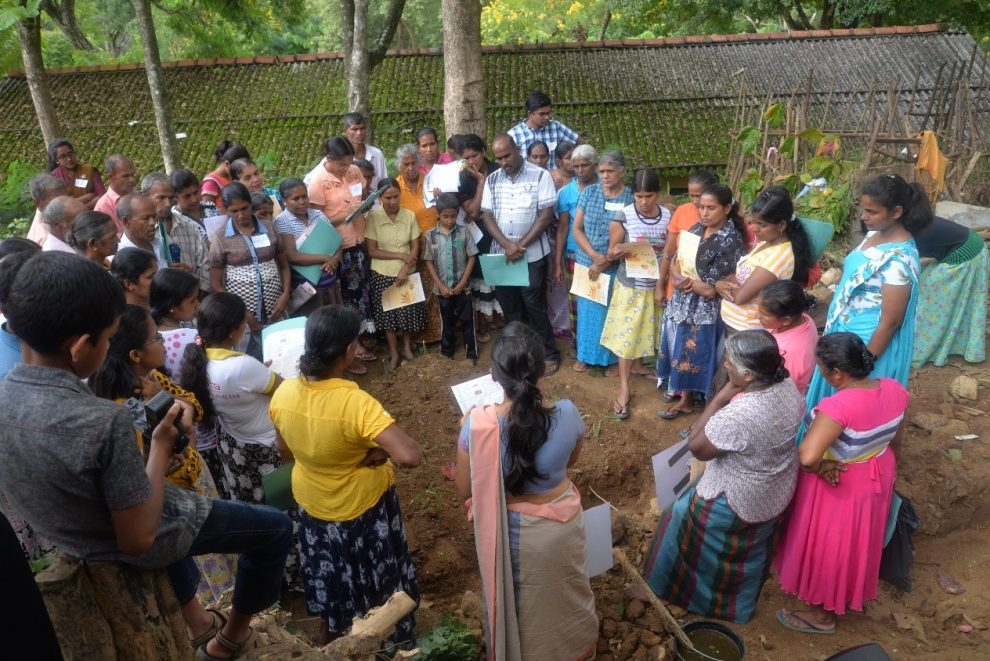

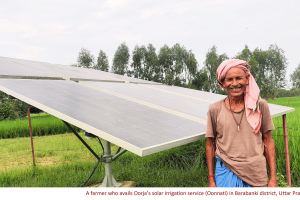
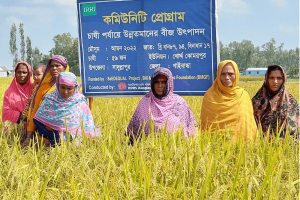
Thanks Ms Yasara for giving your reflections on the use of PRA tools to identify training needs and organising training programmes to address them. Although these exercises consume lot of time of the faculty and students it is worth it. As you rightly pointed out it is not one way transfer of knowledge as faculty and students also gain from farmers’ rich experiences. I wish agriculture and veterinary colleges in India also employ such tools while teaching extension courses. Congratulations.